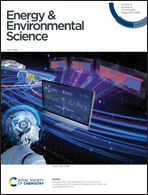Additive engineering with 2,8-dibromo-dibenzothiophene-S,S-dioxide enabled tin-based perovskite solar cells with 14.98% power conversion efficiency†
Abstract
As the most promising lead-free perovskite, tin-based perovskite has attracted much attention due to its suitable bandgap and low toxicity. However, many defects (tin vacancy defects caused by Sn2+ oxidation to Sn4+, grain boundary defects and point defects) in tin-based perovskite lead to serious losses in device efficiency. Here, a universal and effective doping strategy is delivered to improve the structure and optoelectronic properties of tin-based perovskite films through 2,8-dibromo-dibenzothiophene-S,S-dioxide (BrDS) doping. The introduction of BrDS can effectively inhibit the oxidation of Sn2+ and passivate grain boundary defects and point defects in the perovskite films. The tin-based perovskite film doped with BrDS exhibits higher carrier lifetime and crystal quality. As a result, the BrDS-doped device achieves a power conversion efficiency of 14.98% with a certified efficiency of 14.36%, which is one of the highest PCEs among all values reported to date for tin-based PSCs. In addition, the BrDS-doped PSC devices exhibit significantly improved long-term stability and improved operational stability in a N2 atmosphere. This work represents a noteworthy step towards manufacturing efficient and stable tin-based PSCs.



 Please wait while we load your content...
Please wait while we load your content...